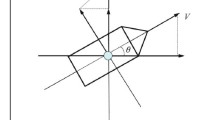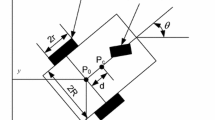Abstract
A systematic control design strategy of the trajectory tracking controller is proposed for a class of chained nonholonomic systems with full-state constraints. The barrier Lyapunov function (BLF) with finite-time convergence, the technique of relay switching and the integral backstepping are applied to the development of the controller. The designed control law guarantees that the reference trajectory can be tracked by the system state asymptotically and the state constraints are not violated. The physical models of two mobile robots and simulation results are provided to demonstrate the effectiveness of the proposed control scheme.
Similar content being viewed by others
References
O. J. Sordalen and O. Egeland, “Exponential stabilization of nonholonomic chained systems,” IEEE Trans. Autom. Control, vol. 40, no. 1, pp. 35–49, Jan. 1995.
R. M. Murray and S. Sastry, “Nonholonomic motion planning: Steering using sinusoids,” IEEE Trans. Autom. Control, vol. 38, no. 5, pp. 700–716, May 1993.
Z. P. Jiang, “Robust exponential regulation of nonholonomic systems with uncertainties,” Automatica, vol. 36, no. 2, pp. 189–209, 2000.
R. W. Brockett, R. S. Millman, and H. J. Sussmann, Differential Geometric Control Theory, Birkauser, Boston, MA, 1983.
S. S. Ge, Z. P. Wang, and T. H. Lee, “Adaptive stabilization of uncertain nonholonomic systems by state and output feedback,” Automatica, vol. 39, no. 8, pp. 1451–1460, 2003.
Y. Q. Wu, F. Z. Gao, and Z. G. Liu. “Finite-time state-feedback stabilisation of non-holonomic systems with low-order non-linearities,” IET Control Theory Appl., vol. 9, no. 10, pp. 1553–1560, 2015.
Z. R. Xi, G. Feng, Z. P. Jiang, and D. Z. Cheng, “Output feedback exponential stabilization of uncertain chained systems,” J. Franklin Inst., vol. 344, no. 1, pp. 36–57, 2007.
Y. G. Liu and J. F. Zhang, “Output feedback adaptive stabilization control design for nonholonomic systems with strong nonlinear drifts,” Int. J. Control, vol. 78, no. 7, pp, 474–490, 2005.
Y. Q. Wu, B. Wang, and G. D. Zong, “Finite-time tracking controller design for nonholonomic systems with extended chained form,” IEEE Trans. Circuits Syst. II, Exp. Briefs, vol. 52, no. 11, pp. 798–802, Nov. 2005.
Y. Zhao, J. B. Yu, and Y. Q. Wu, “State-feedback stabilization for a class of more general high order stochastic nonholonomic systems,” Int. J. Adapt. Control Sign. Proc., vol. 25, no. 8, pp. 687–706, 2011.
K. D. Do, “Global inverse optimal stabilization of stochastic nonholonomic systems,” Syst. Control Lett., vol. 75, pp. 41–45, 2015.
Y. Q. Wu, F. Z. Gao, and Z. C. Zhang, “Saturated finite-time stabilization of uncertain nonholonomic systems in feedforward-like form and its application,” Nonlin. Dyn., vol. 84, no. 3, pp. 1609–1622, 2016.
Z. P. Jiang, “Iterative design of time-varying stabilizers for multi-input systems in chained form,” Syst. Control Lett., vol. 28, no. 5, pp. 255–262, 1996.
Y. P. Tian and S. H. Li, “Exponential stabilization of nonholonomic systems by smooth time-varying control,” Automatical, vol. 38, no. 7, pp. 1139–1146, 2002.
J. Luo and P. Tsiotras, “Control design for chained-form systems with bounded inputs,” Syst. Control Lett., vol. 39, no. 2, pp. 123–131, 2000.
J. P. Hespanha and A. Stephen Morse, “Stabilization of nonholonomic integrators via logic-based switching,” Automatica, vol. 35, no. 3, pp. 385–393, 1999.
C. X. Wang and Y. Q. Wu, “Finite-time tracking control for strict-feedback nonlinear systems with full state constraints,” Int. J. Control, vol. 92, no. 6, pp. 1426–1433, 2019.
Z. C. Zhang and Y. Q. Wu, “Further results on fixed-time stabilization and tracking control of a marine surface ship subjected to output constraints,” IEEE Trans. Syst., Man, Cybern.: Syst., 2019. DOI: https://doi.org/10.1109/TSMC.2019.2950329
Z. C. Zhang and Y. Q. Wu, “Adaptive fuzzy tracking control of autonomous underwater vehicles with output constraints,” IEEE Trans. Fuzzy Syst., 2020. DOI: https://doi.org/10.1109/TFUZZ.2020.2967294
B. Niu, Y. Liu, G. Zong, Z. Han, and J. Fun, “Command filter-based adaptive neural tracking controller design for uncertain switched nonlinear output-constrained systems,” IEEE Trans. Cybern., vol. 47, no. 10, pp. 3160–3171, Oct. 2017.
J. Fu, J. M. Faust, B. Chachuat, and A. Mitsos, “Local optimization of dynamic programs with guaranteed satisfaction of path constraints,” Automatica, vol. 62, pp. 184–192, 2015.
Y. J. Liu, S. M. Lu, S. C. Tong, X. K. Chen, C. L. P. Chen, and D. J. Li, “Adaptive control-based barrier Lyapunov functions for a class of stochastic nonlinear systems with full state constraints,” Automatica, vol. 87, pp. 83–93, 2018.
W. He, Z. Yan, Y. Sun, Y. Ou, and C. Sun, “Neural-learning-based control for a constrained robotic manipulator with flexible joints,” IEEE Trans. Neur. Net. Lear. Syst., vol. 29, no. 12, pp. 5993–6003, Dec. 2018.
Z. C. Zhang, Y. Q. Wu, and J. M. Huang, “Differential-flatness-based finite-time anti-swing control of underactuated crane systems,” Nonlin. Dyn., vol. 87, no. 3, pp. 749–1761, 2017.
Y. J. Liu, Q. Zeng, S. Tong, C. L. P. Chen, and L. Liu, “Adaptive neural network control for active suspension systems with time-varying vertical displacement and speed constraints,” IEEE Trans. Ind. Electron., vol. 66, no. 12, pp. 9458–9466, Dec. 2019.
C. X. Wang, Y. Q. Wu, and J. B. Yu, “Barrier Lyapunov functions-based adaptive control for nonlinear pure-feedback systems with time-varying full state constraints,” Int. J. Control, Automation, Syst., vol. 15, no. 6, pp. 2714–2722, 2017.
Y. J. Liu and S. C. Tong, “Barrier Lyapunov functions-based adaptive control for a class of nonlinear pure-feedback systems with full state constraints,” Automatica, vol. 64, pp. 70–75, 2016.
B. Niu and J. Zhao, “Tracking control for output-constrained nonlinear switched systems with a barrier Lyapunov function,” Int. J. Syst. Sci., vol. 44, no. 5, pp. 978–985 2013.
Y. Wu and X. J. Xie, “Robust adaptive control for state-constrained nonlinear systems with input saturation and unknown control direction,” IEEE Trans. Syst., Man, Cybern.: Syst., 2019. DOI: https://doi.org/10.1109/TSMC.2019.2895048
Y. Wu and X. J. Xie, “Adaptive fuzzy control for high-order nonlinear time-delay systems with full-state constraints and input saturation,” IEEE Trans. Fuzzy Syst., vol. 28, no. 8, pp. 1652–1663, 2020.
J. W. Xia, J. Zhang, W. Sun, B. Y. Zhang, and Z. Wang, “Finite-time adaptive fuzzy control for nonlinear systems with full state constraints,” IEEE Trans. Syst., Man, Cybern.: Syst., vol. 49, no. 7, pp. 1541–1548, Jul. 2018.
W. He, A. O. David, Y. Zhao, and C. Sun, “Neural network control of a robotic manipulator with input deadzone and output constraint,” IEEE Trans. Syst., Man, Cybern., Syst., vol. 46, no. 6, pp. 759–770, Jun. 2016.
W. He, Z. Yin, and C. Sun, “Adaptive neural network control of a marine vessel with constraints using the asymmetric barrier Lyapunov function,” IEEE Trans. Cybern., vol. 47, no. 7, pp. 1641–1651, Jul. 2017.
W. Sun, S. F. Su, J. W. Xia, and V. T. Nguyen, “Adaptive fuzzy tracking control of flexible-joint robots with full-state constraints,” IEEE Trans. Syst., Man, Cybern.: Syst., vol. 49, no. 11, pp. 2201–2209, Nov. 2019.
H. K. Khalil, Nonlinear Systems, Prentice-Hall, New Jersey, 2002.
S. Song, J. H. Park, B. Zhang, and X. Song, “Observer-based adaptive hybrid fuzzy resilient control for fractional-order nonlinear systems with time-varying delays and actuator failures,” IEEE Trans. Fuzzy Syst., 2019. DOI: https://doi.org/10.1109/TFUZZ.2019.2955051
S. Song, J. H. Park, B. Zhang, X. Song, and Z. Zhang, “Adaptive command filtered neuro-fuzzy control design for fractional-order nonlinear systems with unknown control directions and input quantization,” IEEE Trans. Syst., Man, Cybern.: Syst., 2020. DOI: https://doi.org/10.1109/TSMC.2020.2967425
Author information
Authors and Affiliations
Corresponding author
Additional information
Publisher’s Note Springer Nature remains neutral with regard to jurisdictional claims in published maps and institutional affiliations.
Recommended by Editor Jessie (Ju H.) Park.
This work was supported by the National Natural Science Foundation of China (61673243, 61803228 and 61703232), the China Postdoctoral Science Foundation (2018M632645), the Major Scientific and Technological Innovation Project in Shandong Province (2019JZZY011111), and by the Key Laboratory for Robot & Intelligent Technology of Shandong Province.
Zhongcai Zhang received his M.S. degree in automatic engineering from Qufu Normal University, Qufu, China, in 2013 and a Ph.D. degree in automatic control from Southeast University, Nanjing, China, in 2016. He is currently an associate professor with the School of Engineering, Qufu Normal University, Rizhao, China. His current research interests include nonlinear system control, nonholonomic system control, underactuated system control, adaptive theory, and robot applications.
Wenli Cheng received her B.S. degree in automation from Qufu Normal University, Qufu China in 2017 where she is currently working toward an M.S. degree in the School of Engineering. Her research interests include the control of underactuated systems and wheeled mobile robots.
Yuqiang Wu received his M.S. degree in automatic engineering from Qufu Normal University, Qufu, China, in 1988 and a Ph.D. degree in automatic control from Southeast University, Nanjing, China, in 1994. He is currently a Professor with the School of Engineering, Qufu Normal University, Rizhao, China. His current research interests include variable structure control, switching control, nonlinear system control, stochastic systems, and process control.
Rights and permissions
About this article
Cite this article
Zhang, Z., Cheng, W. & Wu, Y. Trajectory Tracking Control Design for Nonholonomic Systems with Full-state Constraints. Int. J. Control Autom. Syst. 19, 1798–1806 (2021). https://doi.org/10.1007/s12555-020-0225-z
Received:
Revised:
Accepted:
Published:
Issue Date:
DOI: https://doi.org/10.1007/s12555-020-0225-z




